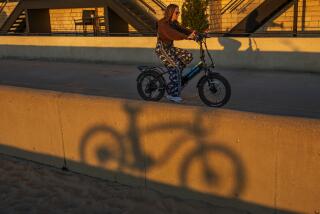County Leads State in Pedestrians’ Deaths, Study Finds
- Share via
Four pedestrians die each week in Los Angeles County in traffic-related accidents, and injuries occur at a rate of about one every two hours, according to a new study, which also found that young Latinos and African Americans face the greatest peril.
Those numbers put Los Angeles County, where 200 pedestrians were killed and 5,500 injured in 1998, at the top of the state casualty list for anyone on foot, say researchers for the Surface Transportation Policy Project in a study to be released today.
The county also comes out on top when those numbers are compared to the level of pedestrian activity.
Young Latinos and African Americans, more dependent on walking or riding bicycles than any other segment of society, were among those most vulnerable to being hit by a motor vehicle and represent a disproportionate share of the pedestrian victims in the state, according to the study.
Pulling together data from the California Highway Patrol, the state health department, the U.S. Census Bureau and other agencies, the study found that Latinos 21 and younger accounted for 47.9% of the state’s pedestrian fatalities and injuries in 1996, but made up only 38.5% of the population. Roughly twice as many African Americans 21 and younger died or were injured than their share of the population would indicate.
The study found that being hit by a car while walking is the second leading cause of death for California children ages 5 to 12.
The report also cited a study by the Santa Ana Unified School District showing that nearly half the pedestrian accidents reported in that city during one five-month period involved children walking near schools.
Statewide, nearly 5,000 children on foot are injured each year, a rate of nearly 14 per day.
The study cited densely populated city areas, motorists who turn wide boulevards into speedways during their morning and evening commutes, and the heavy foot traffic in some neighborhoods as contributing to the toll.
Those factors clearly were in evidence Tuesday at Edgeware Road and Temple Street in Echo Park, a heavily Latino neighborhood near downtown Los Angeles.
As cars sped by, crossing guard Yolanda Acosta ushered children from Betty Plasencia Elementary School, half a block from the intersection, across the street. Acosta, employed by the city of Los Angeles’ Department of Transportation, said she hasn’t seen any pedestrian accidents at the intersection but has witnessed a number of near misses.
Several mothers tightly clutching the arms of their children were among those crossing the intersection. Several months ago, Rosie Quintero said, she saw an older woman in a crosswalk knocked off her feet and thrown at least 10 yards by a car.
“It’s bad,” she said, relating stories of having to dodge motorists. Like her neighbors, Quintero, 26, prefers to walk, even though she has a car. “Everybody in this neighborhood walks,” she said.
Josephine Gonzalez, who doesn’t own a car, walks every day to pick up her daughter, Anna Christina, 8, at school. “I don’t trust the cars,” she said. “I don’t let my daughter walk home alone.”
Statewide, pedestrian deaths account for more than 20% of traffic-related fatalities each year, the study said.
Orange County had the fifth-highest number of fatalities and fourth-highest number of pedestrian injuries in 1998, according to the report. Ventura, San Bernardino and Riverside counties were also near the top of the list.
The surface transportation project, based in Los Angeles and Washington, D.C., uses its research to advocate more environmentally friendly land use and transportation policies. The nonprofit organization represents a coalition of environmental groups such as the Sierra Club and Friends of the Earth, as well as unions, transportation planners and others.
Among those who contributed to the study was Luis Arteaga, policy director of the San Francisco-based Latino Issues Forum.
Raised in a Latino neighborhood in Los Angeles, Arteaga said that all his life he had heard stories about the dangers to pedestrians, particularly children, in densely populated neighborhoods. “We wanted to compile data that would get behind the anecdotes,” he said. “Unfortunately we found they were true.”
The study argues that funding for pedestrian safety programs is not even on the radar screen compared to the money pouring into highway and bridge construction. It said the California Department of Transportation “spends less than 1% of its federal traffic safety funds on pedestrians, even though more than 20% of all traffic fatalities statewide are pedestrians.”
Jim Drago, a Caltrans spokesman, said the study did not take into account the pedestrian components of major transportation projects, such as sidewalks and shoulders built along roadways. “Under our bridge replacement program, we have shoulders and sidewalks especially for pedestrians, but that is not specifically listed as a pedestrian safety project,” he said.
(BEGIN TEXT OF INFOBOX / INFOGRAPHIC)
Dangerous Paths
In 1998, more pedestrians died or were injured in auto-related accidents in Los Angeles County than anywhere else in California. Statewide, pedestrians account for more than 20% of all traffic-related fatalities. Below are the counties with the most pedestrian deaths and injuries.
*
Sources: Surface Transportation Policy Project, September 1999;
California Highway Patrol
More to Read
Sign up for Essential California
The most important California stories and recommendations in your inbox every morning.
You may occasionally receive promotional content from the Los Angeles Times.













